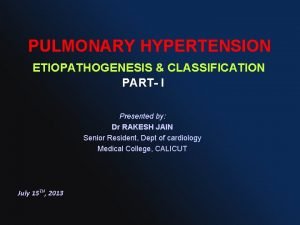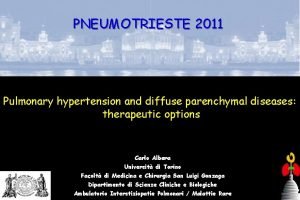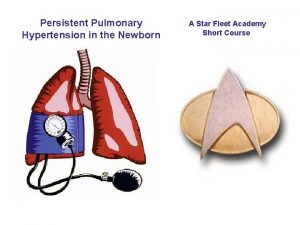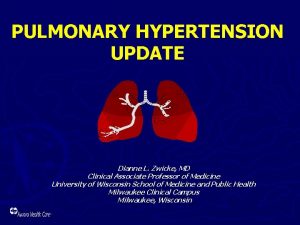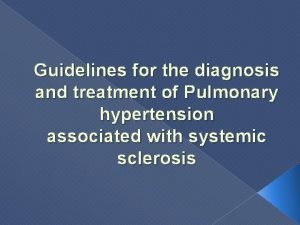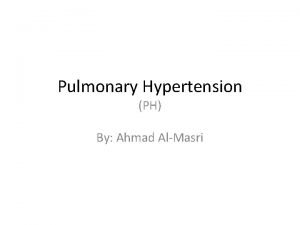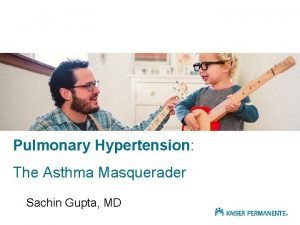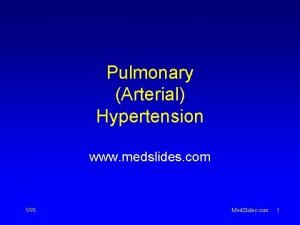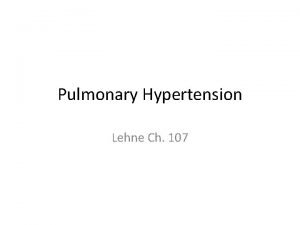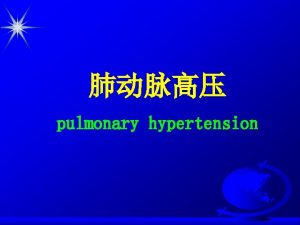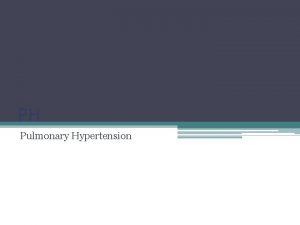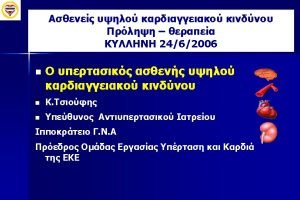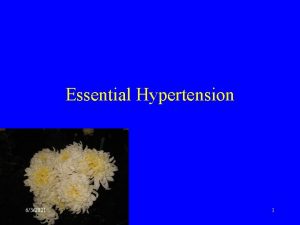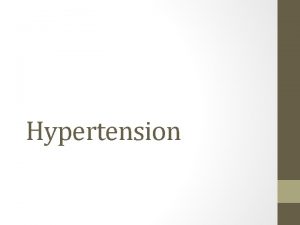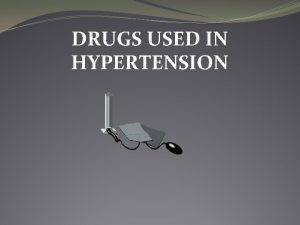PULMONARY HYPERTENSION Pulmonary hypertension PH is defined as










- Slides: 10

PULMONARY HYPERTENSION • Pulmonary hypertension (PH) is defined as a m. PAP of ≥ 25 mm. Hg at rest or ≥ 30 mm. Hg upon exertion. • Women with pulmonary hypertension from whatever cause are at increased risk during pregnancy. • The maternal mortality rate was 40%, but more recent data suggest this may have fallen to about 10%– 25%. • Two subgroups exist: I- Some patients have a positive pulmonary vasodilator response and may be treated with calcium antagonists to lower their pulmonary pressures. II- Some other women show a fixed PVR and those should be actively advised against pregnancy and adequate contraception’s recommended. • Signs and symptoms: - Dyspnea - Palpitations - Chest Pain - Syncope - Lower limb edema • Causes: I- PAH (Idiopathic) II- Left-sided heart failure III- Lung diseases & hypoxemia IV- Chronic VTE V- Others (connective tissue diseases and congenital heart diseases)

MANAGEMENT • If women with pulmonary hypertension become pregnant, termination should be considered. Termination itself is associated with maternal mortality in up to 7%, but this is less than the risk associated with such a pregnancy allowed to progress. • Principles of management include: • Antenatal Care: I: PAH-targeted therapies: -Phosphodiesterase inhibitors (sildenafil, tadalafil). -Prostanoid analogues (epoprostenol & iloprost) and nitric oxide. -Endothelin receptor antagonists (bosentan, ambrisentan). II: Thromboprophylaxis with LMWH. III: Timely admission. • Peripartum Care: -Planning of elective delivery. -Management in an intensive care environment. -Avoiding hypovolaemia. -Avoiding acidosis. -Avoiding pulmonary artery catheters. -Avoiding systemic vasodilation.

CONGENITAL HEART DISEASE • The incidence of congenital heart disease in pregnancy is increasing. • The most common congenital heart diseases in pregnancy are patent ductus arteriosus (PDA), ASD and VSD). Together these account for about 60% of cases. • Simple acyanotic defects and uncomplicated left-to-right shunts pose little problem, and women with defects of minimal haemodynamic significance do well in pregnancy. • Most common: -Patent Ductus Arteriosus: -Atrial Septal Defect -Ventricular Septal Defect -Congenital Aortic Stenosis -Coarctation of the Aorta -Marfan’s Syndrome -Cyanotic Heart Diseases: o Pulmonary Atresia o Tetralogy of Fallot

• Patent ductus arteriosus: -Corrected cases pose no problems in pregnancy and do not require antibiotic prophylaxis. -Uncorrected cases usually do well but are at risk of congestive cardiac failure. • Atrial septal defect: -Usually well tolerated in pregnancy. -Potential risk of paradoxical embolism but risk is low. -Women may become hypotensive if there is an increase in the left-to-right shunt following blood loss at delivery. This causes a drop in left ventricular output and coronary blood flow. • Ventricular septal defect: -Usually well tolerated in pregnancy unless the woman has Eisenmenger’s syndrome. • Coarctation of the aorta: -If diagnosed, this is usually corrected prior to pregnancy but residual coarctation is not uncommon. -The risks with uncorrected coarctation are angina, hypertension and congestive heart failure. There is also an association with aortic rupture and aortic dissection. -It is important to document the form of surgical repair undertaken (stent, subclavian flap, excision with end-to-end anastomosis) and also to perform an MRI, preferably prior to pregnancy, to exclude any aneurysms or post-stenotic dilatation around the site of repair. -The risk of aortic dissection may be minimized by strict control of the blood pressure and β-blockade to decrease cardiac contractility.

MARFAN’S SYNDROME • It’s an autosomal dominant connective tissue disorder that may lead to various CVS abnormalities like mitral valve prolapse and aortic regurgitation, aortic root dilation and aortic rupture or dissection. • Pregnancy increases the risk of aortic rupture and dissection with a MMR of around 50%. • Predictors for dissection and rupture include: -Pre-existing or progressive aortic root dilatation (10% risk if root >4 cm). -Positive family history of dissection or aortic rupture • Echocardiogram is the principle investigation. It helps to determine the size of the aortic root, and is to be performed serially throughout pregnancy, especially in women who enter with an aortic root dilation of >4 cm. Those with a dilation of <4 cm are at a lower risk of aortic rupture and dissection and the risk of adverse cardiac events (of ~1%). • Obstetric complications described in women with Marfan’s: -Miscarriage -Preterm labour -Cervical weakness/insufficiency -Uterine inversion -PPH

MANAGEMENT • Pregnancy is contraindicated if the aortic root is >4– 4. 5 cm. • Patients at high risk (and particularly if root >4. 5 cm) should be offered aortic root replacement prior to pregnancy. • β-blockers have been shown to reduce the rate of aortic dilatation and the risk of complications in patients with Marfan’s syndrome. They should be continued or started in pregnant patients with aortic dilatation. • Regular echocardiograms should be carried out to assess aortic root diameter. • Elective caesarean section (CS) is usually recommended for women with aortic roots showing progressive enlargement or >4. 5 cm. • Genetic counseling: -The risk of the fetus having a congenital heart defect is higher if the mother rather than the father has congenital heart disease. Overall, the risk is about 2%– 5% (double the risk in the general population). -In women with an ASD, the risk of an ASD in the fetus is about 5%– 10%; for aortic stenosis, the risk is highest (18%– 20%). -Both Marfan’s and hypertrophic cardiomyopathy have autosomal dominant inheritance. -Women with congenital heart disease should be referred for a detailed fetal cardiac ultrasound.

DISSECTION OF THE AORTA • Pregnancy increases the risk of aortic dissection, which is a common cause of death in pregnancy. • Clinical features: -Acute severe chest pain, particularly if the pain is described as ripping or tearing, with interscapular radiation, jaw pain and the presence of systolic hypertension and/or differential blood pressures in each arm. • Risk factors: -Marfan’s syndrome -Loeys–Dietz syndrome -Turner’s syndrome -Ehlers–Danlos syndrome (EDS) type IV -Coarctation of the aorta -Bicuspid aortic valve • Diagnosis: -Chest X-ray is mandatory and may show mediastinal widening, but a normal chest X-ray does not exclude the diagnosis. -Diagnosis may be confirmed with transthoracic or TOE, CT or MRI • Expeditious delivery by CS

PLANNING FOR DELIVERY • Most women with cardiac disease are able to and should be encouraged to have normal vaginal deliveries. Each case should be assessed individually taking into account past medical and obstetric history. • This includes: -Planned mode and place of delivery -Induction and augmentation of labour -Guidance regarding I. V fluids and anticoagulation • Cardiac indications for elective CS are limited to: -Dilated or expanding aortic root (>5 cm in bicuspid valve, >4. 5 cm in Marfan syndrome) -Severely impaired left (systemic) ventricular function

Points to remember • Common in pregnancy and mostly benign. • Pulmonary hypertension and fixed PVR are dangerous and often fatal in pregnancy. • Other contraindications to pregnancy include a dilated aortic root >4. 5 cm, severe left heart obstruction from critical mitral or aortic stenosis and severe impairment of left ventricular function. • Any strategy for anticoagulation for a pregnant woman with a mechanical heart valve is associated with risks to the mother and/or fetus. Careful, informed and balanced pre-pregnancy counseling is vital. • Peripartum cardiomyopathy should be treated with conventional heart failure therapy (including thromboprophylaxis), with the exception that ACE inhibitors are withheld until after delivery. • Women with significant heart disease need multidisciplinary care in a specialist centre by obstetricians, cardiologists and anaesthetists with expertise in the care of heart disease in pregnancy. Agreed management plans should be carefully documented. • If pregnancy is contraindicated, then appropriate contraceptive advice is paramount.

THANK YOU
